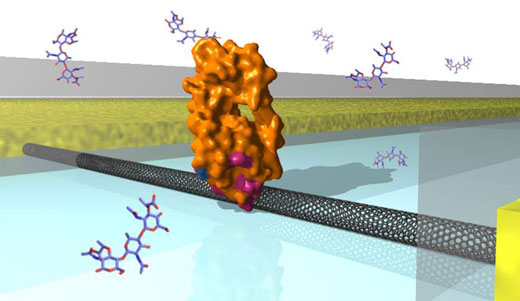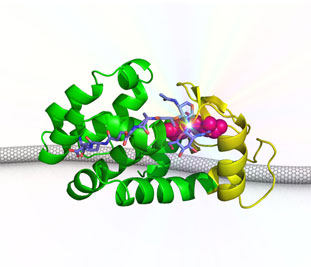For the Record
January 25, 2012 / By Anna Lynn Spitzer
UC Irvine physics associate professor Philip Collins specializes in building tiny electronic circuits at the nanoscale – devices a fraction the size of a wavelength of light. These circuits aren’t visible to the naked eye; they can only be detected with high-powered scanning electron or atomic force microscopes.
Now, along with chemist Gregory Weiss and six other UC Irvine collaborators, Collins has successfully joined these miniscule circuits to molecules called lysozymes, obtaining for the first time a recording of the individual molecules in action.
Collins describes lysozyme as the Pac Man of the immune system. The protein, which resides in tears, saliva and other body fluids, “chomps” its way through bacteria – hundreds of times per second – destroying them to keep us healthy. For years, scientists have worked to unlock the secrets of this complex molecule.
Now, their understanding of lysozyme’s behavior has advanced significantly. “Single-Molecule Lysozyme Dynamics Monitored by an Electronic Circuit,” published today in the journal Science, details the researchers’ feat: recording the proteins’ activities by attaching them to tiny electronic circuits that served as molecular-scale microphones.
“The recording had so much detail. It was amazing,” says Collins.
Researchers grew and purified the lysozyme molecules in the lab and used a chemical reaction to attach them to carbon nanotube transistor circuits. Then, the devices were measured in a room-temperature saline solution with different types of bacteria. “These are proteins that live in you and me, and we’re trying to duplicate that type of environment,” Collins says.
 |
|
The lysozyme device, which consists of the molecules and the carbon nanotube circuit, pictured on a substrate.
|
By running a voltage through the nanocircuit, the researchers in essence “turned on the microphone,” allowing them to monitor the signals produced by a single lysozyme molecule as it attached, detached and attacked other molecules.
“It’s the changes in the current that tell us what the lysozyme is doing at the moment,” explains Collins. “It’s quiet when no bacteria are around, and then it’s chomp, chomp, chomp when its favorite food is present.”
The lysozymes function at two speeds, and the collaborators were able to distinguish what factors caused them to switch gears. Additionally, they mutated individual amino acids in the proteins to determine the effects on the molecules’ behavior.
|
This blending of electronics and biology, known at UCI as LifeChips, is a Calit2 research focus. “By taking two fields like electronics and molecular biology and smearing the boundary between them, we’re able to do new research that’s never been possible before,” says Collins, who serves on the Calit2 Advisory Board. “Nobody has been able to watch a protein in action by combining it with electronics.”
The novel approach is already spawning follow-up papers, one of which is scheduled for publication next month in theJournal of the American Chemical Society. “It’s very exciting to work on something a long time and then have it begin working so well,” Collins enthuses. “Our initial results four years ago suggested this was going to be almost impossible. But as we improved our techniques, it just got easier and easier.”
Next on the research agenda is attaching the circuits to other molecules to track their behaviors. “We think we can do this with any molecule,” Collins says.
If so, the work will have long-range implications. The researchers are already beginning to work on other complex molecules like DNA, and there’s potential in using the technique to detect and control disease, decipher the behavior of cancer cells and manufacture synthetic drugs.
“This is just a first step,” Collins says. “But you definitely have a clear path from this research to a versatile tool for the development of new drugs, antibiotics and a better understanding of how our immune system works.”
-- Anna Lynn Spitzer


